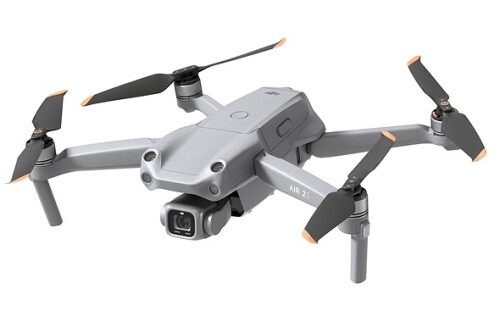
DJI has unveiled the Air 2S, a follow up to the compact Mavic Air 2. Most notably, the drone features a camera with a 1" sensor, capable of capturing 20MP photos and up to 5.4K/30p or 4K/60p video. Improvements in its Spotlight 2.0 tracking capabilities, plus an upgraded APAS 4.0 obstacle avoidance and detection system, have also been added.
The Air 2S is 180×97×80 mm folded down, not much different in size from the Mavic Air 2. It's the most compact drone to feature a camera with a 1" sensor and a pixel size of 2.4μm. Nestled on a 3-axis gimbal and stabilized by RockSteady EIS, it has a 22mm (35mm equiv.) fixed-aperture F2.8 lens with an 88º FOV and can capture 20MP stills including timed photos, AEB (in 3 and 5 brackets) and panoramas.
SmartPhoto is also available. First introduced on the Mavic Air 2, deep learning and analysis technology will detect which settings are the best to capture a particular scene, such as a sunset, and automatically create the most appealing image – this includes HDR, Hyperlight, and Scene Recognition.
HDR merges several images together while Hyperlight works to enhance imagery in low-light environments. Scene Recognition identifies common settings such as snow, sky, or grass and makes proper adjustments for what DJI refers to as the best possible image.
The camera records video up to 5.4K/30p, 4K/60p or 1080p/120p at 150 Mbps with an H.264 or H.265 codec. Users can zoom in on subjects up to 4X at 4K/30p, 6X at 2.7K/30p, 4X at 2.7K/60p, 6X at 1080p/60p and 8X at 1080p/30p. Three different video color profiles are available: Normal (8 bit), D-Log (10 bit) or HLG (10 bit). 8GB of internal storage is onboard the aircraft in case a memory card is forgotten or it runs out of space.
With the Air 2S DJI is introducing MasterShots, a feature that automatically plans a flight's path and merges the final footage for a professional-grade video clip that can be instantly shared. QuickShots, including Rocket, Asteroid, Boomerang and Dronie can be easily accessed. FocusTrack uses Point of Interest 3.0 to identify and track a subject. Draw a box around it and the drone will create an automated flight path. Hyperlapse video can be captured in resolutions up to 4K.
The Air 2S comes with sensors on top of the aircraft and also features four-way obstacle avoidance detection. According to DJI, APAS 4.0 offers a wider FOV for improved detection of obstructions. When recording up to 4K/30p video, the drone can instantly maneuver over, under and around obstacles.
DJI's latest OcuSync (O3) is onboard for a stable streaming feed at a maximum distance of 12km (7.45 miles). In ideal conditions, the drone can fly up to 31 minutes with one battery. It is also equipped with ADS-B technology to detect any nearby manned aircraft including small planes and helicopters. An improved RTH (Return-to-Home) feature, which automatically brings the drone back to the pilot if the connection is lost, or the battery runs critically low, has also been included.